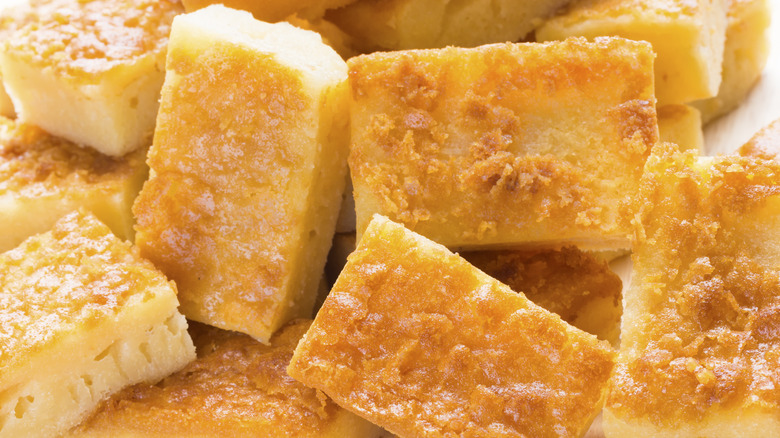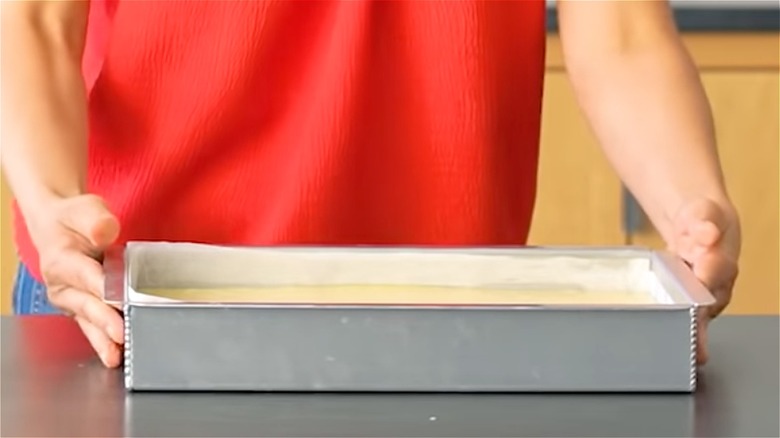The Secret For Perfect Butter Mochi Relies On The Type Of Pan You Use
Delectably chewy, intensely rich and buttery, and springy to the touch, the glorious Hawaiian classic butter mochi is a celebration of fusion excellence. It owes its popularity to the flavorful combination of coconut milk and the sweet rice flour mochiko, with a subtle nuttiness and undertones of vanilla. The texture of butter mochi sits between a custard-like Japanese mochi and a moist coconut cake. Baked in a rectangular or square pan, the mochi develops crisp, golden edges that provide the perfect contrast to the firmer, custard-like filling of the center. The mochi can be garnished with coconut shavings, glazed with fruity sugar, or sliced into bars and devoured immediately.
To truly experience the unique taste of this island specialty, it is important to use the correct kind of baking pan. Although a glass baking pan can offer an easy way to view your bake's rise, they aren't necessarily the best choice for baking butter mochi. A metal baking pan is more appropriate, and there are several scientific reasons why.
Butter mochi likes metal
A metal baking pan is beneficial as it conducts heat from the oven much faster than glass. This allows you to achieve a more uniformly baked butter mochi with a taller rise and crispier edges. A metal baking pan also holds the advantage of beginning to cool immediately once it's removed from the oven. Because of this rapid heat transfer, the metal can protect the butter mochi from continuing to bake. The ideal butter mochi center should spring back when pressed, not remain indented or be too firm.
Glass, on the other hand, is an insulator — not a conductor — of heat. This means that glass takes longer to heat up than metal, and retains that heat for longer periods. Compare it to your home's windows — if they were metal instead of glass, the winter chill would seep in a lot faster.
What this means for baking butter mochi is that the characteristics of glass present two challenges. Once removed from the oven, a glass container will retain heat, which risks overcooking the sides and bottom of the mochi, thus darkening and hardening the edges beyond the desired golden hue. Secondly, a glass pan may continue cooking the center, altering the delightful squidgy middle into a firmer texture. If using a glass dish is unavoidable, it's recommended that you reduce the mochi's baking time by at least 5 minutes.
A dark or light colored pan?
Diving deeper into the realm of metal baking pans, you might also want to consider the best color of metal pan to use for butter mochi. Darker metal pans absorb heat, which radiates off the surfaces of the pan. Therefore, a darker metal is likely to produce bakes with darker or crispier bottoms or sides since it tends to cook the outer layers of the cake more rapidly than the center. On the other hand, light-colored metal pans tend to reflect heat. Thus, the bottom and sides of baked goods typically brown more slowly and uniformly.
The color of a glass baking pan tends to follow the principle that darker hues absorb more heat than lighter ones, as with metal pans. Tinted glass tends to absorb more heat than transparent glassware, and retains heat for a slightly longer time than clear glass. Hence, mochi butter baked in a tinted pan may be prone to quicker baking, resulting in browned bottom and edges. To achieve a visually appealing and deliciously tasting butter mochi, start with a metal baking pan. You will be delighted by the results.


